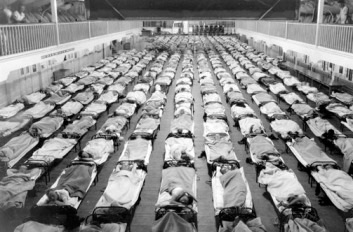"I dare say that the world has never before known a pestilence more widespread, more intensive and appalling in its progress or more destructive to life than the epidemic of influenza" -Victor C. Vaughn, Surgeon General of the Army
Welcome to Influenza 1918: A snapshot of the great Pandemic

This site is dedicated to telling the story of the 1918-1919 Influenza in Butler County. The blog has a time line chronicling the virus as it swept across the country and the world. The site features a photo gallery, displaying various images of the pandemic. In addition to photographic evidence the site has a host of "flu facts" concerning the 1918 influenza as well as examining its role during the first World War. Lastly the site provides insight into the influenza in Butler County.
WHERE DID THE FLU ORIGINATE?
There is much speculation to the origins of the flu virus. Epidemiological evidence complied from Dr. Loring Miner, a doctor who was practicing medicine in Haskell County Kansas, suggests the Flu began at Fort Riley Kansas in March 1918. Kansas' physical geography lent itself to the spread of disease. Farmers and animals, such as cattle, pigs, and chickens lived in close proximity to each other. During winters heavy winds blew dust and debris across the plains for hundreds of miles, which allowed for the virus to spread rapidly. The Chief Medical Officer at Fort Funston wrote a telegram on March 30th 1918 to Victor Vaughn, the Army Surgeon General saying, "Many deaths influenza following immediately two extremely sever dust storms." These conditions allow for the spread of airborne illnesses and viruses which soon overwhelmed the doctors and nurses at the training camps as soldiers suddenly became ill.
FIRST SIGNS
It all began on March 18 1918 when An Army cook reported to the infirmary displaying symptoms of the virus. Within a few short fours the doctors were dealing with hundreds of ill soldiers. One week later 502 men were sick. The Flu spread rapidly from camp to camp as soldiers were on the move as they were being shipped out to France during America's involvement in World War I. The flu was spreading to Florida, Georgia, California, Virginia, South Carolina, Alabama, and Pennsylvania. Butler County was affected by the influenza as it lost many of it citizens to the virus especially young men who volunteered for military service. In addition to the service men, who lost their life to the influenza many citizens of Butler were greatly affected by the outbreak. Families lost loved ones to the virus. Daily life and activities were drastically altered the community attempted to contain the flu. The community grappled with the onslaught of such a leviathan pandemic.
WHERE DID THE FLU ORIGINATE?
There is much speculation to the origins of the flu virus. Epidemiological evidence complied from Dr. Loring Miner, a doctor who was practicing medicine in Haskell County Kansas, suggests the Flu began at Fort Riley Kansas in March 1918. Kansas' physical geography lent itself to the spread of disease. Farmers and animals, such as cattle, pigs, and chickens lived in close proximity to each other. During winters heavy winds blew dust and debris across the plains for hundreds of miles, which allowed for the virus to spread rapidly. The Chief Medical Officer at Fort Funston wrote a telegram on March 30th 1918 to Victor Vaughn, the Army Surgeon General saying, "Many deaths influenza following immediately two extremely sever dust storms." These conditions allow for the spread of airborne illnesses and viruses which soon overwhelmed the doctors and nurses at the training camps as soldiers suddenly became ill.
FIRST SIGNS
It all began on March 18 1918 when An Army cook reported to the infirmary displaying symptoms of the virus. Within a few short fours the doctors were dealing with hundreds of ill soldiers. One week later 502 men were sick. The Flu spread rapidly from camp to camp as soldiers were on the move as they were being shipped out to France during America's involvement in World War I. The flu was spreading to Florida, Georgia, California, Virginia, South Carolina, Alabama, and Pennsylvania. Butler County was affected by the influenza as it lost many of it citizens to the virus especially young men who volunteered for military service. In addition to the service men, who lost their life to the influenza many citizens of Butler were greatly affected by the outbreak. Families lost loved ones to the virus. Daily life and activities were drastically altered the community attempted to contain the flu. The community grappled with the onslaught of such a leviathan pandemic.
